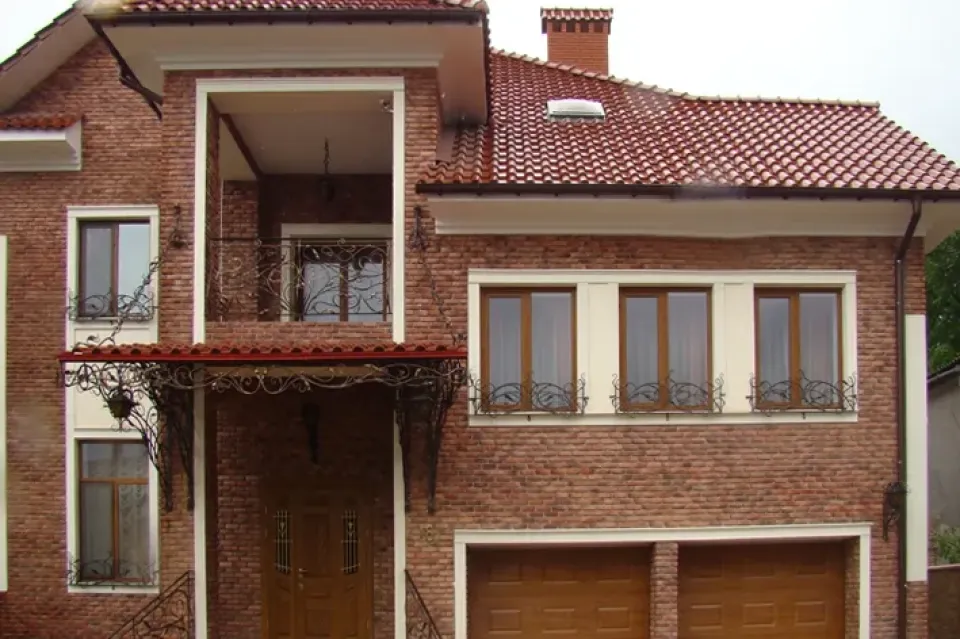
Wet stone is beautiful!
When we leave the house in the morning, we involuntarily take a deep breath to fill our lungs with fresh air, which we miss so much indoors. The feeling is doubly pleasant if the air is cleaned of dust by the night rain that washed the asphalt of roads, stone fences and facades of houses. Water droplets on wet stones look especially beautiful after such rain, shimmering in the rays of the morning sun. However, if a night shower has soaked a sandstone-lined fence and with it the stone facade of your house, then you involuntarily begin to think about their strength and durability. After all, the elements of nature - water, together with frost, wind and sun, can destroy everything, including them.
The durability of a stone surface can be ensured by protecting it from the entire complex of atmospheric influences. The main destructive factors in this complex are: water (mechanical destruction during freezing; environment for the development of fungus and moss); abrasion (destruction during ordinary mechanical impact); sunlight (color fading). Ideally, the stone must be protected from the destructive force of nature. The most common method of protection is to create an obstacle to atmospheric influences directly on the surface of the stone. There are several means for creating such a barrier, and the two most common of them are: water repellents and protective varnishes. To choose one of these means, you need to know what result will be obtained after their use
Using a water repellent, we protect the surface only from water (the effect of a water-repellent surface is created). In this case, we do not get protection from abrasion and sunlight. In addition, the use of water repellents does not give noticeable decorative effects, the color saturation of the treated surface, as a rule, does not change.
To achieve protection of the stone surface from the entire range of atmospheric influences and at the same time to realize design ideas, only treatment with decorative and protective varnish will help. Varnish will protect the stone from all the main destructive factors of the atmosphere, creating a thin, transparent, beautiful decorative film on the surface that is waterproof, durable and contains protection against UV radiation. It does not crack, gives the surface the effect of "wet stone" and light silkiness. In addition, the varnish film emphasizes the texture and color saturation of the treated surface.
There are two main types of protective varnishes for stone: solvent-based and water-based. Solvent-based varnishes are better absorbed into the base and are more wear-resistant, so they are recommended for treating surfaces that are exposed to increased atmospheric and mechanical loads. Solvent-based varnishes are 1.5 ... 2 times more expensive than water-soluble ones and require the use of skin and respiratory protection when applied. Less expensive and more environmentally friendly water-soluble protective varnishes for stone will be effective on less critical surfaces.
An example of solvent-based and water-based protective varnishes is: organic-soluble - GRANIT LAKK S and water-soluble - GRANIT LAKK Aqua. These semi-matte acrylic varnishes for decorative finishing of low-absorbing mineral surfaces are offered by the Eskaro Group AB holding (Sweden).
GRANIT LAKK S and GRANIT LAKK Aqua can be used for both exterior and interior work. The objects of application for GRANIT LAKK Aqua are: interior decoration elements, fireplace cladding, facade and fence elements, facade and wall tiles, fireplace cladding. GRANIT LAKK S is also recommended for these same objects, but its scope of application additionally includes horizontal surfaces: stone terraces and sidewalks, floor and sidewalk tiles. These varnishes are also applied to brick, concrete, clinker, plaster, natural stone (granite, etc.), decorative tiles made of artificial stone, etc.
Surface preparation before applying varnish is mandatory. Remember that no woman will start applying makeup without first washing and wiping her face dry. The surface to be varnished must also be dry, free from sand, dust, dirt, efflorescence, oil and grease. In addition, areas affected by mold or moss must be, firstly: mechanically cleaned; secondly: treated with special agents for the destruction of mold and fungus (for example, BIOTOL or BIOTOL Spray); thirdly: washed with water and dried.
GRANIT LAKK S and GRANIT LAKK Aqua are recommended to be applied with a swab, brush or roller. To obtain the effect of "wet stone" on a moderately absorbent surface, one layer of varnish is enough. If the surface is porous, then a second layer of varnish must be applied - 1 ... 2 hours after the first one has dried.
The Eskaro Group AB holding (Sweden) also offers several glossy acrylic water-based protective and decorative facade varnishes for stone: Aura Dekor Lack, Condor Stein Lack, Grover V451. These varnishes are similar in properties (except for gloss) and purpose to GRANIT LAKK Aqua varnish.
To create an additional decorative effect (color solution) on the treated surface, GRANIT LAKK Aqua can be tinted. However, such a "color varnish" is recommended for use only indoors. The varnish film of both varnishes withstands surface heating up to 80 degrees, so they can be used to treat fireplace cladding.
The presence of wax in them contributes to easy removal of dirt from the surface treated with varnishes.
GRANIT LAKK S and GRANIT LAKK Aqua will not only reliably protect stone surfaces, but also delight your eye, creating a "wet stone" effect in any weather - a feeling of cleanliness and shine from the just-passed rain.







